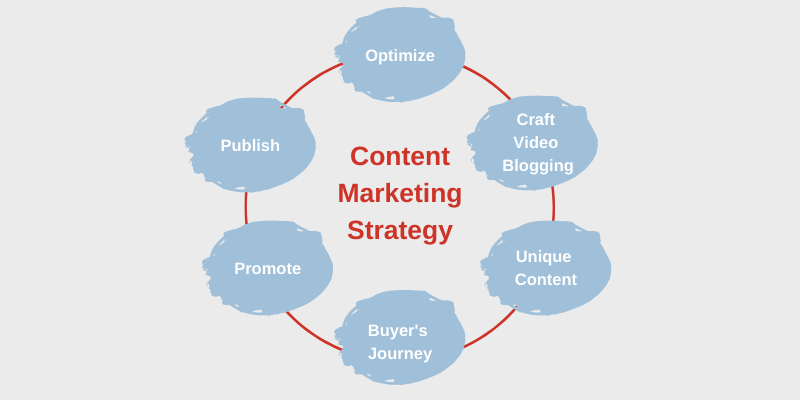In the ever-evolving digital marketing landscape, content marketing is a critical strategy for brands aiming to engage, convert, and retain their audiences. As we approach 2025, several emerging trends are set to redefine how brands connect with consumers. Here’s a look at the key content marketing trends expected to dominate in 2025, helping businesses stay ahead of the curve.
What Have Been the Trends in Content Marketing?

94% of small businesses have been developing and publishing content, blogs, eBooks, newsletters, reports, and white papers, but what percentage of those businesses are doing it effectively? The numbers only indicate that content marketing is working, but not if it is done correctly. While most may be doing well, many businesses still need to work on what marketers are doing and what customers are looking for.
Today’s content marketing is too crowded, and standing out is more complex than before. The need of the hour is to produce high-quality content that sticks out like a sore thumb and connects well with the audience. Finding a content marketing sweet spot that connects well with the audience and expands its relevance is imperative.
Also Read: Effective Proven Content Marketing Strategies for 2024-25
Stay Ahead with the Latest Content Marketing Trends for 2025

Hyper-personalization and AI-driven content
Artificial intelligence (AI) is reshaping content marketing by enabling hyper-personalized experiences at scale. In 2025, brands will rely more on AI algorithms to analyze user behavior, preferences, and past interactions, creating AI content that resonates individually. Personalized content can include dynamic product recommendations, targeted messaging, and content that aligns with individual user journeys.
AI-powered content creation tools, like ChatGPT and other advanced language models, will assist in producing this content efficiently. This combination of AI and personalization will be essential in capturing and holding the audience’s attention in a saturated digital market.
Craft video blogging

The videos are not dead yet. Have you tried them? If not, now is the time to consider video blogging. They are good marketing techniques to trust for 2024. Viral videos are expected to be huge in 2024 and are a great way to build better customer relations. Studies suggest that several people prefer watching a video over reading a blog. The numbers look like 250,000 videos, 600 million video streams, and 18 monthly videos per business – so you understand where we are going.
Videos are important. So, why not create a high-quality video series—a vlog? Establishing a vlogging is important for your business to connect with your audience and build a fan community. Many companies and individual vloggers use video marketing—TEDx, Content Marketing Institute, Backlinko, and many more.
For example, Brian Dean of Backlinko gives marketing tips on SEO and link-building strategies to entrepreneurs and startups through video tutorials. The first video was uploaded or published on YouTube in 2014, and today, it has 85K subscribers and just 17 videos. The video lasts 6 to 14 minutes, with actionable tips and techniques for marketers. The video audience includes Disney, Apple, IBM, and Amazon marketers. That’s the power of video blogging, and today, he is one of the most popular marketing bloggers online.
Most businesses will add YouTube and Facebook videos to their marketing plan in 2024. Facebook Live is commonly used by companies and is used squarely to create hype around product releases. Since they are unedited copies, they evoke the same emotion from the audience when streamed live. With more ‘How to,’ ‘What,’ and other exciting video content, you can hike Facebook traffic and thus your website traffic. It is time to catch the boat before it is too late.
Also Read: AI vs Human Content Writing – Which is Better?
Rise of AI-generated media content

AI-generated media content, including imagery, text, and music, will become increasingly prevalent in 2025. As AI technology advances, tools like DALL-E and Runway can produce high-quality, unique visual assets on demand. This capability will help brands create content faster and with more diversity, catering to various audience segments with bespoke designs.
AI-generated content will also facilitate A/B testing and experimentation, allowing brands to quickly iterate and discover what resonates best with their audiences without significant investments in traditional creative resources.
Utilize voice and audio content
With smart speakers and voice-activated devices becoming more widespread, audio content is seeing a renaissance. In 2025, brands will likely invest heavily in voice search optimization and audio-based content. Podcasting, audiobooks, and bite-sized audio content are all expected to grow as audiences look for ways to consume content on the go.
Voice search optimization will also be essential as more people rely on voice commands to find information. Content strategies must adapt to natural language patterns, focusing on answering questions directly and clearly to match conversational queries.
Prominence of sustainability and ethical content
Consumers are becoming more conscious of environmental and ethical issues, and this shift will only intensify in 2025. Brands that prioritize transparency, ecological responsibility, and ethical storytelling will gain the trust and loyalty of audiences. Content will reflect this shift by highlighting sustainability initiatives, responsible practices, and honest brand narratives.
Brands should also consider sustainability in their digital content strategies. Minimizing digital waste and energy consumption—optimizing website performance, reducing unnecessary data storage, and using sustainable servers—will contribute to a greener digital ecosystem.
User-generated content (UGC) as social proof
User-generated content (UGC) remains a powerful trust-building tool, and in 2025, brands will take it further by weaving UGC into every part of their content strategy. Consumers increasingly seek authenticity, and UGC offers real-life perspectives on products and services, which often resonate more than branded content.
Brands will increasingly use UGC for social proof, particularly on social media, e-commerce websites, and email marketing campaigns. To encourage UGC, brands might offer incentives, create hashtag challenges, or highlight community stories, building an ecosystem where customers feel like integral parts of the brand’s story.
Augmented reality (AR) and virtual reality (VR) experiences
As AR and VR technologies advance, more brands adopt immersive content experiences, bridging the physical and digital gap. For example, AR can let customers “try on” products virtually, like furniture in their homes or makeup on their faces. At the same time, VR can offer complete brand experiences through virtual tours or interactive campaigns.
In 2025, more brands will incorporate AR and VR content into their websites, apps, and social media. This technology will mainly impact the fashion, real estate, and travel industries, where immersive experiences can enhance decision-making.
Also Read: Strategies to Optimize Your Content Marketing
Content optimization and repurposing
Crafting relevant and updated content is crucial, but brands also realize the value of repurposing and optimizing existing evergreen content. Rather than constantly creating new content, marketers in 2025 will focus on updating high-performing content to keep it relevant and align with SEO trends.
Repurposing content into multiple formats—such as turning blog posts into infographics, podcasts, or videos—will help brands get the most mileage out of each piece, maximizing reach without overwhelming resources. This strategy allows brands to reinforce key messages consistently across different platforms.


